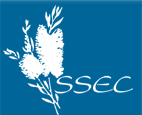
|
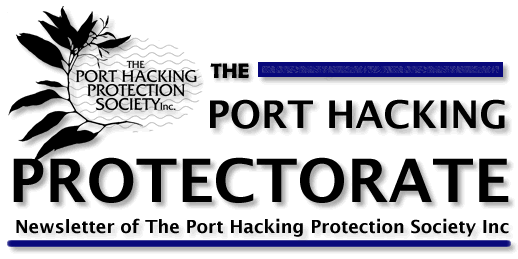 |
December 1995 |
|
Editorial
Whos Responsibility? |
 |
Port Hacking is used by a plethora of groups and individuals as well as forming the public space amenity for the occupants of some 7,000 foreshore and semi-foreshore households. For all its users, residents and visitors alike, a safe, clean and aesthetic environment is the essential consideration.
Ultimately, the task of implementing and policing regulations which are meant to maintain the Port's pristine nature and repair damage already caused by human activity rests with Regulatory Agencies. The illustration on p8 indicates the number of government and semi-government authorities currently involved in implementing regulations that directly concern usage and development on Port Hacking. Understandably there is overlap, fragmentation, gaps in responsibility and jurisdictional disputes. Couple this with the limited resources faced by all government authorities, and effective regulation of activities and abuses around Port Hacking is less than ideal.
However the problem with the current diverse range of responsibilities is not only less than optimal policing. The problem is that any proposed plan of management that potentially deals with a specific problem in the Waterway, crosses the domains of so many authorities that it is difficult to obtain agreement or priorities for implementation.
Dredging channels in Port Hacking is a good example.
Dealing with the issue of whether or not to dredge the channels of Port Hacking at all and what impact on the environment and on the usage pattern of Port Hacking is in itself complex enough. Nevertheless it is possible to address these and arrive at a plan of management. In fact the Port Hacking Planning and Advisory Committee did just that with its Memorandum of Understanding (see p.11).
However effective implementation of the Memorandum of Understanding needs the agreement, support and effective cooperation of a range of groups and regulatory authorities including: Waterways Authority, Sutherland Shire Council, boating user groups, Environment Protection Agency, National Parks and Wildlife Authority, NSW Water Police and Fisheries Department. All these groups have their own agendas and concerns. The issues identified by the Memorandum of Understanding that fall under their jurisdiction may not be a priority for any one or all of these groups. This results in a lapsing of commitment to the Memorandum and ultimately a limiting of the usefulness of the Plan of Management. |
| Any plan of management that attempts to deal with a specific problem in Port Hacking crosses the jurisdiction of so many regulatory authorities, it is difficult to obtain agreement or priorities for implementation |
|
This appears to be what has occurred with the Memorandum of Understanding. Dredging work has commenced but the other components of the Memorandum, the basis on which other users of the Port agreed to the dredging proposal and the basis on which the State Government agreed to fund dredging, have not been implemented. The backlash of lopsided implementation of the plan of management will be a degraded environment and less likelihood of gaining funding for ongoing dredging work or agreement on future dredging proposals.
Since 1992, PHPS has consistently emphasised the need for a single regulatory Authority for Port Hacking and its catchment. Without a single Authority, every plan of management will be inefficiently and ineffectively implemented.
The Port Hacking Planning and Advisory committee of Council has as one of its main objectives to "Assist Council in the preparation of a plan of management for Port Hacking and develop policies and action to secure its implementation..." Such a Plan of Management was prepared and adopted by Council in November 1992. Implementation, however, has been slow. The Committee's work appears not to be a priority for Council. In 1995 the Committee has met irregularly and is apparently not scheduled to meet again till March 1996.
The Port Hacking Protection Society lobbies Council to honour its commitment to the Plan of Management. However ensuring the proper maintenance and management of the Port's environment is surely the concern of each citizen. The more pressure placed on Council by residents and users of the Port to act positively towards safeguarding our unique waterway, the more likely Council will make implementation of the Plan of Management a priority. |
On 10 and 11 November we sent a letter to all Councillors asking them each to answer three questions with regard to Port Hacking:
-
To what degree do you support the Memorandum of Understanding (the basis for State Government approval of maintenance dredging) and Sutherland Council's Plan of Management for Port Hacking?
-
What issues concerning Port Hacking do you think Council should focus on?
-
What changes would you like to see with regard to the way Sutherland Shire Council is currently dealing with issues around Port Hacking
We asked Councillors to provide us with a response in time for this publication. We were able to make contact with or were contacted by six of the fifteen Councillors: Councillors Paul Smith, Phil Blight, Dawn Emerson, Kevin Schreiber, David Redmond and Tom White. Councillors Paul Smith and Phil Blight, who sat on the Port Hacking Planning and Advisory Committee, were supportive of the Memorandum of understanding and all its implications and had defined views on issues concerning Port Hacking. However, a number of Councillors, especially those recently elected to Council, noted that they required more time to bring themselves up-to-date on issues concerning Port Hacking and especially on the Memorandum of Understanding. We understand that there are many pressures on new Councillors and that this time of the year is an especially busy one. However, we do look forward to publishing the responses of all Councillors to the above questions in the next issue of the Protectorate due out in April 1996. |
|
Port Hacking Planning & Advisory Committee
A significant achievement of the Port Hacking Protection Society has been to persuade Sutherland Shire Council to adopt a plan of management for Port Hacking. We gave a detailed outline of the contents of the plan of management in issue 6 (Nov. 93) of the Port Hacking Protectorate. In order to implement that Plan, a subcommittee of Council was appointed, called the Port Hacking Planning and Advisory Committee. Paul Martin provided a report on the achievements of the Committee earlier this year in issue 8 (May 95) of this newsletter.
One of the first actions taken by the newly elected Sutherland Council (Sept. 95) was to call for a report on Council's subcommittees, including the Port Hacking Planning and Advisory Committee. That report was provided to Councillors by 16 October 1995. It called for slight amendment to bring it up to date with the directions and objectives being followed by the Committee and listed the achievements to date and relevance of the committee. Extracts from that report are noted in the box accompanying this article. |
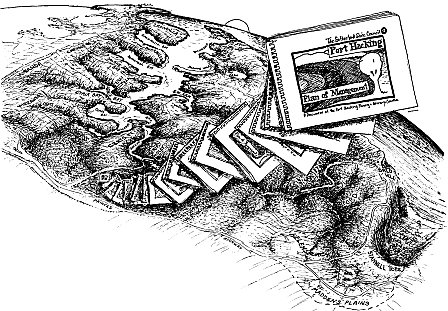 |
A step Council has taken is to combine the Yowie Bay Estuary Management Sub-Committee and the Port Hacking Planning and Advisory committee. The Yowie Bay Estuary management Sub-Committee has a very specific purpose to resolve the issue of siltation of the two heads of Yowie Bay and to go through the formalised steps required to allow Council to gain all the necessary approvals to carry out works and to be eligible for Grant Funding in accordance with the provisions of the Estuary management manual of the New South Wales Government.
So far the Yowie Bay Estuary Management Subcommittee has secured Grant Funding of $12,500 which was matched on a dollar for dollar basis by Council for the purpose of engaging a consultant to collect appropriate data and prepare a Processes Study. The data has been collected and the Processes Study is about 95% completed at this time. |
Extracts from the report on the Port Hacking Planning and Advisory Committee prepared for Council
Achievements
-
Ongoing Port Hacking Management Plan
-
tool for implementation.
-
$245,000 grants via Hacking River care for catchment
-
GPTS Wetlands in catchment (reported on in issue number 9 of the Protectorate).
-
$500,000 maintenance dredging for Port Hacking.
Relevance
-
Link between Council, State Government Departments and local community for a wide range of technical issues relative to the Port.
-
Link with Hacking River Catchment Management Committee.
Role
-
To advise the Council through the Environmental Planning Committee on all matters related to the preservation, maintenance, development and use of Port Hacking.
-
To assist Council in the preparation of a plan of management for Port Hacking and the development of policies and action to secure its implementation, with due regard to council's "Objectives in Relation to Waterways" as listed hereunder:
-
To accept the responsibility for preserving and enhancing this recognised regional resource.
-
To promote the efficient use of the waterways for the purpose of recreation and tourism.
-
To retain and improve upon the existing visual amenity now enjoyed by those using the waterways and by those who enjoy the use of its hinterland.
-
To protect the ecosystem associated with the river system and improve the quality of that ecosystem where possible.
-
To encourage the efficient and safe use of the waterways as a transportation corridor.
-
To achieve a balance between the desires of landowners and the preservation/enhancement of the regional water resource and its visual catchment.
Membership of the Committee comprises:
-
Four Councillors
-
The Shire Engineer, Shire Health Surveyor and Shire Planner
-
Five citizen nominees appointed by the Council whose interest are in accord with the objects of the Committee
When originally constituted this committee also had representatives from National Parks and Wildlife Services, Fisheries Department, Department of Public Works, Department of Sport Recreation and Tourism. Apparently these representatives still sit on the Committee though their membership was not recorded on the report to Council.
Interestingly, clause 3.2 on membership reads: "Membership shall be subject to termination if, at a meeting of members, three-quarters of the members present at such meeting decide that it would be in the best interest of the Committee if the membership of a particular member or members was terminated". |
|
Stop Press
Funding approved
Earlier this year, the Port Hacking Protection Society (PHPS), made an application under the Landcare grant scheme to obtain funding for the continued publication and distribution of this Newsletter.
Funding was approved!
An argument PHPS used in its application was that the newsletter provided a means for disseminating information and for debate to occur regarding issues to do with Port Hacking. So if you want to express a view about something that's happening in Port Hacking or some issue we've raised in the newsletter please write or fax or phone us!
PO Box 744 SUTHERLAND NSW 2232 Ph: (02) 523 3680
Hovercrafts!
Sunday peace was shattered on Horderns Beach at Bundeena with the invasion of hovercrafts. These excessively noisy vessels can be either single person, or carry up to 3 or 4 people. The occupants are thoughtfully provided with earmuffs to reduce hearing damage, but citizens on the foreshore, or enjoying the beach, just have to put up with the pain. These vessels made several runs up and down the beach, sometimes in the water, sometimes on the beach, which raises some interesting questions over jurisdiction. Vehicles are prohibited from all public beaches in the Sutherland Shire, except for the purposes of boat launching. The hovercrafts in question definitely travelled on the beach, as well as parking on the beach. We presume they must obey the same rules that apply to jetskis and other craft with relation to swimmers. PHPS will attempt to get some clarification on this issue for a coming Protectorate. If you are annoyed by behaviour of any craft on the water ring the Waterways Authority on 3642888. If noise is, in your opinion, excessive, contact the Environment Protection Authority on 131555.
Boat Ramp at Bonnie Vale - not now
The National Parks and Wildlife Service has released an information paper on the proposed boat launching facility at Bonnie Vale in the Royal National Park. PHPS (Inc.) has been involved in this issue from its inception, attending meetings, round table discussions and presenting submissions.
In an Information Paper, which follows an Environmental Impact Assessment carried out by private consultants, the NPWS informs us that it has decided to allow continuation of boat launching at the present site with some management improvements and close monitoring of impact. The NPWS has decided against any construction of a formal facility. The NPWS argues that; "the dominant legal requirement....is to manage the area for the purposes required by the National Parks and Wildlife Act, the Plan of Management and Draft plan of Management for the Royal National Park." As these documents are still under review no final decision will be taken at this stage. The paper concludes; "Until the Draft Plan of Management is adopted and detailed planning of the Bonnie Vale area can be undertaken, the launching of boats at the traditional site will continue." Progress on Dredging
Two dredges arrived at Port Hacking at the beginning of November to begin the work of clearing channels in Port Hacking. One dredge began work south of Burraneer Point, removing 55,000 cubic metres of sand in less than a week and opening more than 70 metres of channel. The second dredge will clear the channel off Lilli Pilli.
Sand to be removed from the channels over the next 10 weeks will be pumped through large pipes connected to the dredges and into deep water in Burraneer Bay and near Lilli Pilli Point.
Sutherland Shire Council officers have been monitoring the impact of dredging work on water quality and thus far have reported no adverse effect. |
 |
Stable development
A reader recently sent us this clipping from the Wollongong Advertiser with the accompanying comment:
"4 stables and building debris next to the Hacking River is not good news". |
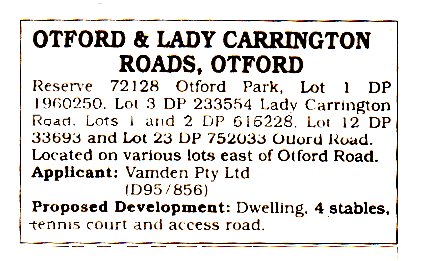 |
Bonnie Vale: Has it Direction?
Brian Page, Maianbar
It is nearly a decade since the demise of the proposed Tombolo. At that time, National Parks and Wildlife Service promised a "Master Plan" for the area.
Bonnie Vale is one of the jewels of Sydney. A good rail service to Cronulla, a lovely ferry trip to Bundeena and a pleasant walk to the pleasure grounds of Bonnie Vale. It is an asset appreciated by both the NSW tourism industry as well as local industry.
But what is the state of our pleasure ground?
Firstly the rangers quarters take up the prime water front location and this comprises an ugly daggy dwelling and work sheds. How do NPWS justify this? Any astute management would have them in a discrete position. Do they have to house employees at this location?
Secondly, NPWS paid out a lot of money on an EIS for a boat ramp which was scheduled to be put on display in May. It has been completed but where is it? It is being held up in all the other studies being done. (see report, above)
Thirdly the camping grounds are a disgrace. It is one of the worst I've seen in my travels around Australia. They need more shade trees and more Bar-B-Que facilities. |
 |
While the main part of Bonnie Vale is a pleasure ground where people can play, swim catch a fish, there are parts close by that are pristine and need to be protected by properly constructed walkways to keep flora and fauna healthy.
Vehicle Parking is "ad hoc" and facilities are dismal. But the Park Use fees has risen from $3.00 in (1988) to $7.50 (1995). How does NPWS justify this? Certainly not by service or improvements.
Have the park service any management skills or is it a home for bureaucrats?
In a late October Issue the Leader reported that locals in the Georges River National Park were pushing for free entry to the Park. The villages of Bundeena and Maianbar are almost surrounded by the National Park and residents can't even persuade the NPWS to allow a properly maintained track of a couple of kilometres through the national park between the villages.
Who's Involved?
An overview of the range of groups, businesses, committees and Authorities involved in a variety of activities around Port Hacking. |
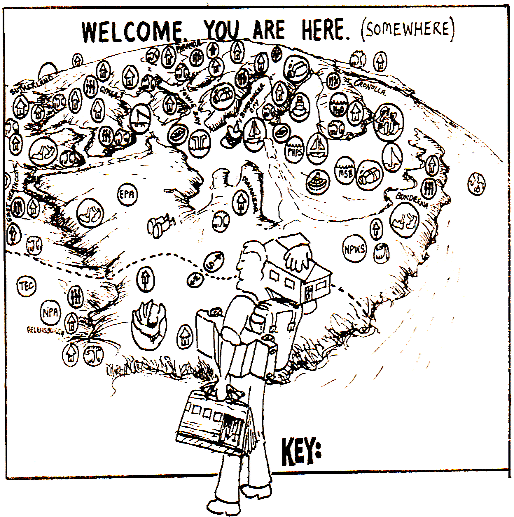
 |
Watercraft Regulation on Port Hacking
With the summer season fast approaching, the use of water craft on Port Hacking will increase. In past issues we have published information about regulations controlling the use of Personal Water Craft (PWCs - such as JetSkis, Sea Doos, Waverunners, etc.) on waterways. In Port Hacking, policing of appropriate watercraft use, including not only PWCs but also other watercraft is carried out by staff of the Waterways Authority Botany Bay/Port Hacking Sub Region. |
 |
The Waterways Authority uses a number of vessels including PWCs on the waterway. Its current patrolling vessel is a six-metre Broadbill. This is to be replaced within the next few weeks by a Sailfish in 2C survey capable of going offshore, fitted with twin 130 horsepower motors and long-range patrolling capacity.
Port Hacking is regularly patrolled by Boating Service Officers, both during the week and on weekends. Up to three boating officers and one area manager may be operating at any given time.
Over the past twelve months twenty-four watercraft users have been cautioned, eighteen have been fined and five have been prosecuted (four of these still in the pipeline). Offenders range from unlicensed ten-year olds to middle-aged adults of either sex. Complaints received from the Waterways Authority range across a variety of vessels, from large motorised vessels to PWCs. |
Who to call if you are concerned about watercraft activity on Port Hacking |
|
During office hours call: 524 7899 |
| On weekends call the Boating Information Line: 131256 |
| Or the Port Hacking Operating Centre on: 364 2000 |
| If any of these fail to respond, call the Georges River Boating Officer on: 0418976164. |
| Remember that the Waterways Authority is able to act upon complaints if it was unable to respond to a call on time. What the Authority needs to have from the complainant is simply the registration number of the vessel causing a nuisance or acting dangerously, the number of people occupying the vessel and a signed statement outlining the problem. |
|
Webmaster Note: Contact numbers may have changed since 1995 |
|
History |
On the Eastern coast of Australian land
A river meets the sea. They form an estuary
Of shining water and bars of golden sand
Which trap the channels where the tide flows free... |
|
| So begins a poem describing the history of Fishermans Bay in Port Hacking. The poem goes on to paint a picture of the untouched beauty of the landscape and vegetation that the nomadic aboriginal tribe, the Dharawal, must have enjoyed. Port Hacking's first encounter with "white man" was in 1797 when two young naval officers and a "lad" set out in a row boat, the "Tom Thumb" to find the "shining river some way to the South". But it was not till 1841 that settlers arrived. In 1879 eighteen thousand acres south of the river was declared Australia's first National Park. The bay and adjoining Sandspit Estate remained to form Maianbar. |
 |
Many years went by and two World Wars were fought
Before the first buildings clung to rock and hilly street (1945).
In little huts and fishing shacks people peace and pleasure sought.
In toilsome times the forest calm; cool waters in the summer heat. |
|
| Over the years more people came, shacks were replaced by larger buildings, road access improved bringing more cars, ancient trees fell and bushfires threatened lives and homes. Nevertheless, the place remains idyllic. |
 |
So does the earth, in spite of our treatment which often is wrong.
Struggle to gladden our eyes as its beauty again is reborn.
Our bay, the waves gently lapping, the joyous sound of birdsong.
Our bay, lit by sunsets golden touch or tinted rose in the early dawn.
Anonymous |
|
Memorandum of Understanding
re Navigation in Port Hacking (A summary)The Memorandum of Understanding regarding Navigation in Port Hacking is a significant achievement of the Port Hacking Planning and Advisory Committee. It provides the basis for funding agreement by the NSW State Government for dredging. Involved in developing the Memorandum were a range of regulatory authorities, user groups and environmental groups concerned with activities and developments in the Port. |
 |
Whether or not to dredge Port Hacking and how much to dredge is not simply a financial question, nor is it simply a safety issue. Dredging has three major impacts on the Port.
The first is on the environment. Dredging changes the sea bed, waterflows/currents and biological dynamics of the Port such as the continued expansion of seagrass beds that stabilise the sand.
The second impact is that dredging enables continued and increased use for medium sized recreational vessels. Such vessels require facilities such as marinas and impact the environment during maintenance and use (boat scraping, cleaning, anti-foul, discharges and human wastes). With increased use of areas by such vessels, control costs such as management, supervision of moorings and infrastructure, policing, etc. also increases.
The third impact is more subtle. Provision of channels for use by larger vessels changes the recreational use pattern of the Port:
-
Deeper channels will encourage the use of larger, powered vessels. These intimidate and cause discomfort to less machine intensive users such as swimmers and divers. Smaller powered vessels are a source of disturbance, mainly through irresponsible use such as bothering swimmers or creating noise pollution for residents adjacent to the waterway.
-
Powered vessels also cause more pollution of the waterway. For swimmers, users of non-powered water craft, fishermen, and foreshore users, oil slicks, discarded pollutants and the hidden impacts of pollution on the quality of water and marine life all diminish the quality of their recreational experience, and can lead them to abandon their legitimate recreational pursuits in an area.
|
| The Memorandum provides the basis for the NSW State Government funding of dredging in Port Hacking, It deals with the question of how much public money should be spent on dredging Port Hacking. |
|
A dredging program that will increase the safety of the Port for navigation and have long-term public support must address the above issues by implementing safeguards that limit the growth of recreational pursuits that only exist because of continued expenditure on dredging and effective control of abuses.
Safeguards to limit the growth of recreational pursuits by large vessels are especially needed West of the area bounded by a line between Cabbage Tree Point and Hungry Point. Proposed safeguards are to include:
-
A limitation to the permissible moorings West of this line for vessels to a maximum draught of 1.8 m.
-
Restrictions on the size and number of vessels berthed at or using the marinas West of the line. It is inappropriate to expand marina facilities upstream of Deeban Spit due to navigation, tidal flushing and facility limitations.
-
A clear agreement between all parties as to the specification of the navigation channels which are to be maintained in the long term.
-
Communication on an ongoing basis to the boating community, and foreshore owners, of the limits to the growth in boating uses of the Port, such that individuals choosing to purchase vessels at the larger end of the spectrum can be taken to assume the risks themselves of limited access.
|
| The shoaling of the Port acts as a regulator of navigation within the Port, discouraging larger vessels and limiting the total tonnage carried. In expending public resources to facilitate navigation, these natural limts will be removed. |
|
In order to protect the interests of all users in a balanced and safe way and to preserve the ecological qualities of the Port, policing of existing regulations needs to be more effective than it has been to date. As part of the Memorandum of Understanding, the Port Hacking Planning and Advisory Committee will seek to attain a collaborative enforcement approach between the various regulatory authorities to minimise the current overlaps and gaps in responsibility. There is also a role for increased involvement by community groups such as the Royal Motor Yacht Club and the MSB Waterway Users Group to disseminate information to waterway users and to develop codes of practice for vessel users.
Safeguards are most useful when their impact is properly monitored. Therefore there should be:
-
A quarterly review by the MSB Waterways Authority Users Group
-
Activity measures of the number of incidents attended, reported offences, and problems resolved
-
Compliance as measured by MSB Waterways Authority Surveys
-
Reduction in the reported complaints to the regulatory authorities.
Constant monitoring and seeking of information about usage of the Port is especially important at this time because there is currently very little data about usage patterns in the Port. Port Hacking is a well used recreational area. Its nature and its proximity to urbanised areas make it vulnerable to degradation. Many of the characteristics of the Port have been studied, but there is no clear understanding of the level of recreational usage which would have an adverse impact on the Port. There is also no comprehensive data about the current level and mix of usage of the waterway and foreshores.
With regard to dredging itself, the Memorandum contains a number of underlying Principles:
-
Navigation channels are designed as far as possible to follow "natural" channels.
-
A philosophy of minimal intervention.
-
Sand is to be removed from the "system".
The principles of the Port Hacking Plan of Management are to be fully encapsulated within the dredging plan.
Apart from the content summarised above, the Memorandum provides details on priorities and timing, options for further examination, guidelines for disposal of dredging sand, recommended safeguards, ongoing maintenance details and timing.
Disaster Waiting to Happen?
George Harrison
PHPS (Inc.) has a long-standing concern with the mooring of large commercial vessels in the waters of Bate Bay directly offshore from Cronulla's beaches. Despite the exposed nature of the Bay, and a sea-bed unsuitable for safe anchorage, such vessels are a common sight whenever Port Botany's unloading capacities are slow. |
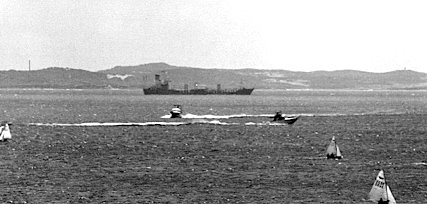 |
The problem was dramatically highlighted in 1990 when the bulk carrier Kouris dragged anchor in a southerly wind and ran aground on Wanda Beach. Disaster was averted more by good luck than by good management. We could well have had a situation similar to the Tamur river in Tasmania earlier this year. One of BHP's bulk manganese carriers ran aground, rupturing diesel fuel tanks and spreading a slick along much of the river. This affected colonies of seabirds and seals, the remoteness of the location and lack of access making rescue and cleanup operations difficult. Ultimately BHP was forced to sink the vessel in deep water, consigning fuel, and the carrier's cargo, to the ocean depths.
How similar is Bate Bay and the Hacking? Not as remote, but just as many problems. The Environment Protection Authority has warned that an oil spill would be difficult to contain within Port Hacking. The tidal flow is strong enough to prevent the efficient use of booms, and the waters throughout the Port are too shallow for the safe use of chemical dispersants. The only course seems to be to allow the oil to come ashore and then undertake a cleanup! This accepts the damage to wildlife habitat, mangroves, saltmarsh, Aboriginal and European heritage areas, fishing and recreation grounds, not to mention the loss of amenity to waterfront owners and visitors.
Cleanup on shore would also not be straightforward. On the southern side of the Port, access is difficult because of the scarcity of roads in the Royal National Park. On the northern shore the terrain is steep and the access by cleanup teams will be predominantly through private property.
Ironically, at this very time, a group of scientists from the Department of Urban Affairs and Planning, and the Defence Science and Technology Organisation, are searching for wrecks in Bate Bay (Leader, 19-10-95). In the course of the search they have discovered that the charts are less than adequate. Director General Gabrielle Kibble said; "An interesting, though unintentional, outcome was that the side scan has suggested that the existing charts do not entirely correspond with the actual extent of the reef." This is a further argument against Bate Bay as a safe anchorage.
The Port Hacking Planning and Advisory Committee has suggested that Sutherland Shire Council write to the Australian Maritime Safety Authority seeking a definite North/South boundary of 151 degrees 11 minutes east as the limit for mooring. This line runs several hundred metres east of Jibbon and Bombora, and is the eastern boundary on maps of the Royal National Park.
PHPS (Inc.) encourages readers of the Protectorate to write to The Australian Maritime Safety Authority, Level 3, 66 Wentworth Ave, Sydney. Fax 2820750, to express concern on this issue, and to call for the implementation of a no-mooring zone for large vessels.
Time to Face Up to Water Cycle Management
Paul Martin Sydney Water have put the Cronulla Sewerage Treatment Plant Environmental Impact Statement 'on hold'. Why? They can't find an effective means for disposing of the vast quantities of water.
Consider this:
- over 2000 new homes connect to Cronulla system annually;
- rain creates runoff into the Hacking and other waterways;
- Bundeena/Maianbar wait for a solution to their sewerage ;
- the water supply of Sydney remains in jeopardy;
- debate continues over a water supply from the Shoalhaven.
The list of water problems could go on for pages. It is costing us dearly to ignore the natural reticulation system for water.
Isn't it time we faced up to the issues?
We transport water in ever increasing quantities. The bulk of our water goes to the garden, the toilet and for washing.
We build giant dams. We flood rivers, bushland and farmland. We remove land from use. We promote contamination of the rivers.
And then we pump the bulk of our water to large treatment plants, and try to work out what to do with it.
Each few weeks the heavens open and we are deluged with clean water. Very little of this is used.
Our received wisdom is that an efficient water system is measured by the quantities that are moved by man. It doesn't make sense. Not from an environmental viewpoint. Not from an economic viewpoint. Not from a social responsibility viewpoint.
The water cycle approach |
| An efficient water system should be measured by how little water has to be moved by man. There are two shifts in thinking. The first is to integrate the management of all water - rainwater and runoff, drinking, washing and gardening. The second is management on the site. This occurs on rural properties - the rain is captured, water used sparingly. What can be re-used is recycled. |
|
A case in point
It has been falsely represented that the Port Hacking Protection Society has opposed the sewering of Bundeena/Maianbar. Our stance has been to encourage the broadest possible consideration of the alternatives. Neither the politics nor the economics of the issue work in favour of the conventional solution. Taking the following data as the basis for calculation, it is easy to work out how much Sydney Water would have to recover to make this an economic proposition. |
| Capital costs |
$20,000,000 |
| # of households |
1180 |
| Cost of capital |
5.00% |
| Project life (yrs) |
20 |
| Operating cost/annum |
$690,000 |
| Overhead allocation |
10% |
| Profit margin |
2% |
| Cost per connection |
$15,000 |
|
This calculates to a cost of $3,308 for every household, every year. Is this economically viable? When the average Sydney ratepayer pays less than $800 per year?
The hope is that the government will make a political decision to sewer Bundeena Maianbar. It is increasingly a state Liberal electorate in an increasingly strong Liberal seat.
- The Liberals have nothing to lose politically in this area.
- The Labour party have little to win.
- No-one else has the power to overturn the commercial rationale.
Implementation of any approach will take a number of years.
The Port Hacking Protection Society has not taken a stand against conventional sewerage. But we do not believe in the cargo cult, and think that eventually political and economic reality will force proper consideration of the water cycle management approach.
An alternative approach should be fully developed now, rather than in five or seven years time.
What would a water cycle approach mean?
It would mean a much more careful evaluation of the individual sites. It would mean a mix of approaches, including advanced dry composting toilets, far greater use of water storage tanks, more advanced design of greywater absorbtion systems, replacement of wasteful shower roses, community education. The net effect would be to eliminate the sewerage problem. Excess water would then have to be dealt with by either (reduced) pump out, or perhaps an artificial wetland.
The assumed wisdom would have to be questioned - this is the most difficult challenge. People just don't like having to rethink their past approach.
It would not be easy, but it is critical that we try to reverse the destructive logic of water use and treatment. If you are able to help, or interested in this issue, please contact the Port Hacking Protection Society. |
| top of page |
|
